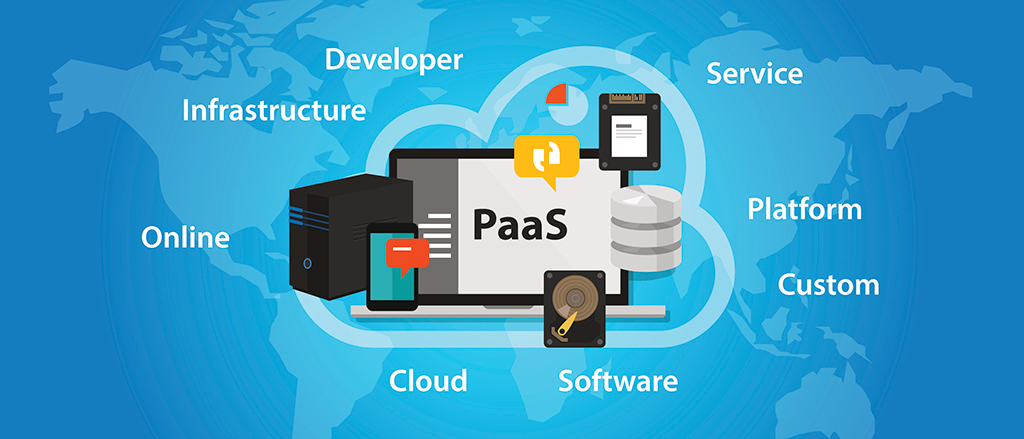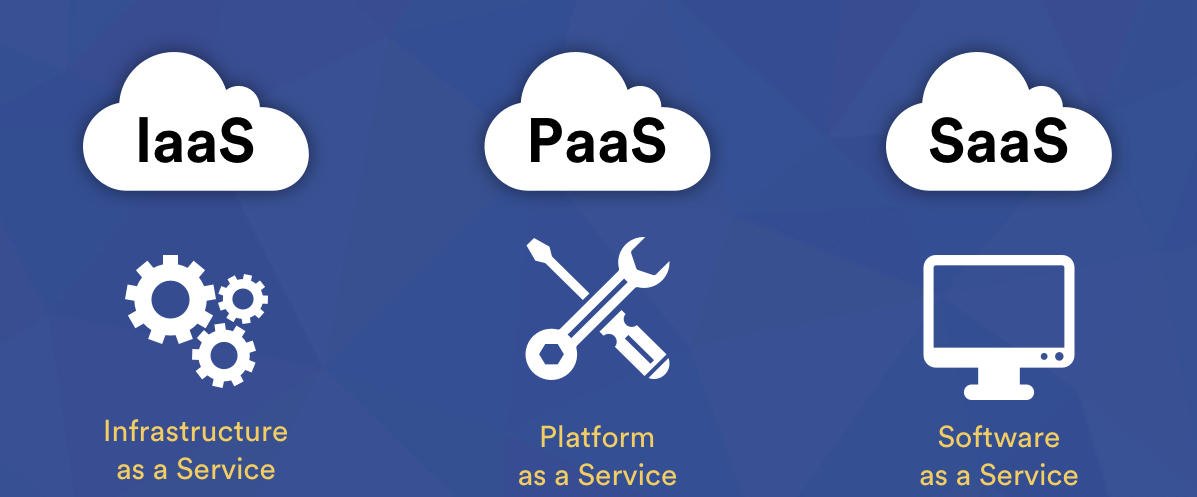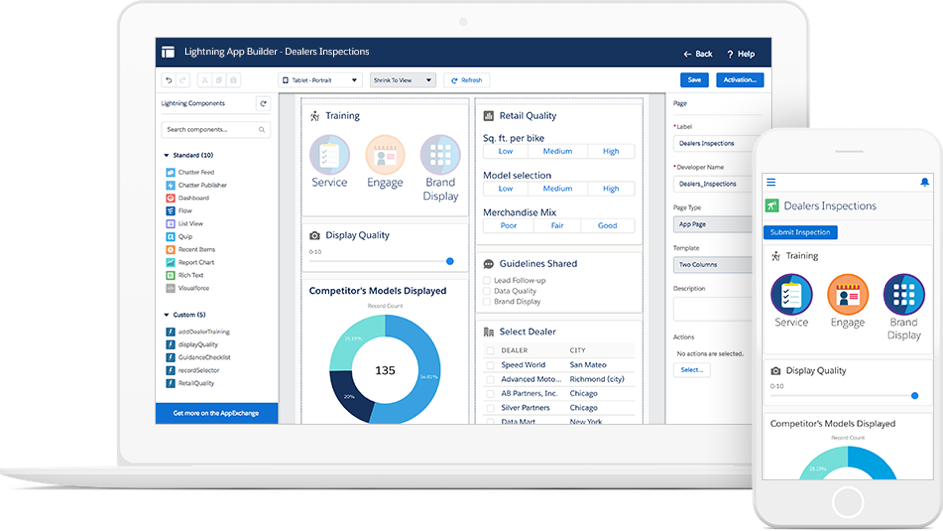What is PaaS?
Nov. 7, 2022 · 7 minutes
The cloud has dramatically changed how business applications are built and run. Delivering a new application is now as fast as opening your Internet browser. Platform as a service (PaaS) is a proven model for running applications without the hassle of maintaining on-premises hardware and software infrastructure at your company. Enterprises of all sizes have adopted PaaS solutions like Salesforce for simplicity, scalability, and reliability. PaaS applications also have the latest features without the pain of constant upgrades.

PaaS provides a huge benefit for companies adopting a microservices architecture, since PaaS allows for each microservice to be deployed and managed faster. PaaS is especially helpful when microservices are built using several different language and frameworks.
Salesforce Lightning Platform brings the trust and speed that are at the core of all our products to building and deploying apps in the cloud. Our built-in features and functionality take care of back-end concerns such as security, infrastructure, and data integration so that you can focus on building your apps faster.
Build apps with PaaS, not infrastructure.
At its core, platform as a service (PaaS) eliminates the expense and complexity of buying, configuring, and managing all the hardware and software needed to run applications.
Why PaaS is being adopted: The traditional application model is broken.
Building and running on-premises applications is complex, expensive, and slow. Traditionally, each on-premises applications require hardware, an operating system, a database, middleware, servers, and other software. Once the stack is assembled, developers need to navigate frameworks like J2EE and .NET. A team of network, database, and system management experts is often needed to keep everything up and running. Inevitably, a new business requirement requires a change to the application, which in turn kicks off another lengthy development, test, and redeployment cycle.
Additionally, large companies often need specialized facilities to house their data centers and a team to maintain them. Enormous amounts of electricity also are needed to power the servers as well as the systems to keep them cool. Finally, a failover site is needed to mirror the data center so information can be replicated in case of a disaster.
Applications built with this complexity and infrastructure are difficult to scale for usage spike demands, and difficult to update as the business needs change.
The Move to PaaS
In the past, businesses started by building and developing their own apps. This demanded server space, software to create programming environments and security to keep everything safe on the premises. That often-meant complex software stacks, frequent updates, hardware maintenance and investing a lot of money in an on-premise environment to help them build apps become outdated very quickly. All in all, an expensive solution in terms of both time and money.
Development tools evolve fast and suddenly you're using yesterday’s interface and yesterday’s technology. Businesses started looking for solutions to help speed up the process and make it cheaper and easier to create the apps they needed. The first to seek more efficient options were businesses already outsourcing other areas of computing services – such as cloud-based software services for recruitment, marketing, or travel and expense management. They looked for an external answer to their internal problem.
PaaS helps developers and business users focus on build great apps with clicks & code without having to worry about infrastructure and operating systems. Development tools, servers and programming environments are readily accessible, via the cloud, without the complexity and expense of creating them in-house. Apps can be developed and hosted faster and with very low setup costs, without the risk of delays or inefficiencies caused by infrastructure issues. Put simply, PaaS allows developers to concentrate on what they do best, so they can produce high-quality results, faster.
PaaS is part of a family of cloud computing tools which includes Software as a Service (SaaS), Infrastructure as a Service (IaaS), and Everything as a Service (XaaS). The cloud computing model allows organizations to outsource computing services so they can dedicate more energy to their core business.

The new model: Cloud apps.
Just as Amazon.com, eBay, Google, iTunes, and YouTube created new markets through a Web browser, PaaS offers a faster, more cost-effective model for application development and delivery.
PaaS provides all the infrastructure needed to develop and run applications over the Internet. Users can access custom apps built in the cloud, just like their SaaS apps, while IT departments and ISVs can focus on innovation instead of complex infrastructure. By leveraging PaaS, organizations can redirect a significant portion of their budgets from “keeping the lights on” to creating applications that provide real business value.
PaaS is driving a new era of mass innovation and business agility. Now, developers can focus on building apps instead of managing complex hardware and software infrastructure.
The Lightning Platform brings together the power of no-code builders and pro-code tools in a single PaaS.

The Lightning Platform combines the power of no-code builders and pro-code tools into one family of services to give you the most complete PaaS toolset toolkit available. You can build employee-facing apps that are mobile and social instantly, create customer-facing apps that deepen customer relationships, and integrate and connect them all more easily and faster.
Five key benefits of building apps with PaaS
Since digital transformation is a key driver of business success, it’s time for businesses to stop thinking of IT as a cost center and start recognizing PaaS app development for what it is: an opportunity waiting to happen.
Every person or company will have their own definition of what agile application development means. No matter how you define it, these five tried-and-true benefits of PaaS can help you transform application development and deliver on the promise of digital transformation every time.
- Data agility
- Enterprise cloud services
- Support for any device
- Declarative app building tools
- Flexibility and scale
1. Data Agility
A custom application is only as good as the data it’s built on. PaaS solutions that are not only built on reliable databases, but also make it easy to integrate with any data, allow for the creation of data-centric apps. This provides a whole new level of connected experience to app users, giving them the relevant, contextual information in real time. Successful businesses rely on the ability to quickly access large amounts of data. Frameworks that put a heavy focus on data, making it easy for low-code developers to embed into applications — all using point-and-click integration tools — mean better, more connected applications delivered much faster than before.
2. Enterprise Cloud Services
Generally, it takes more than a UI to build an application. You need services that power the business logic, integrations, security, authentication, APIs, and the ability to bring in different microservices for features such as maps, RFID, Bluetooth, push notifications, and more into the application. The low-code application development framework provides these services in easy componentized formats so that non-coders can quickly assemble the entire application without touching a single line of code. It is essentially UI plus an out-of-the-box, model-driven cloud services approach that makes PaaS development approach so powerful.
3. Support For Any Device
Rather than depend on a specific web application development framework for web application design and other frameworks for designs for other platforms, businesses benefit from using a single all-purpose PaaS development framework. For a business to stay competitive across all available media, it needs a cross-platform solution that can be used to build web, desktop, and mobile apps, for any type of the device and application architecture — web or native.
4. Declarative App Building Tools
The main draw of PaaS is that it enables non-coders to create high-quality applications fast. Advanced drag-and-drop tools take this a step further. Users can control their development GUI via intuitive mouse controls, selecting and adding elements to their application template with just a click of a button and configuring the underlying business logic by selecting data and actions from a drop-down list. Drag-and-drop tools bridge the gap between application design and the everyday user.
5. Flexibility And Scale
In order to develop apps that fit the unique needs of a business or its clients, organizations need something that is flexible, open, and scalable. All possible programming languages should be supported if the application development framework need to be extended, including Java, HTML5, Ruby, Python, PHP, and any others. Additionally, the framework should be flexible enough to scale up and down based on the transaction volume coming from the users, as well as include built-in services for testing, analytics, and deploying the applications.
References
Contact Us
Contact Info
Address
Maslak Mahallesi, Büyükdere Caddesi, Nurol Plaza 255 B02 Sarıyer, Istanbul, Turkiye
Phone